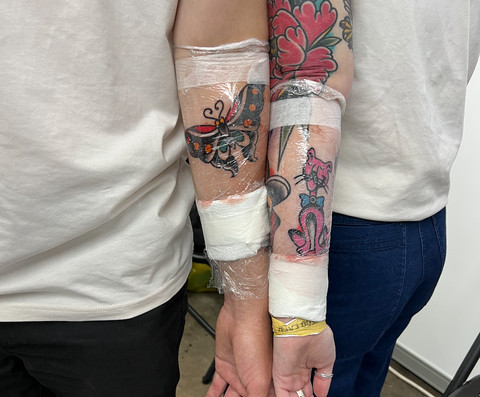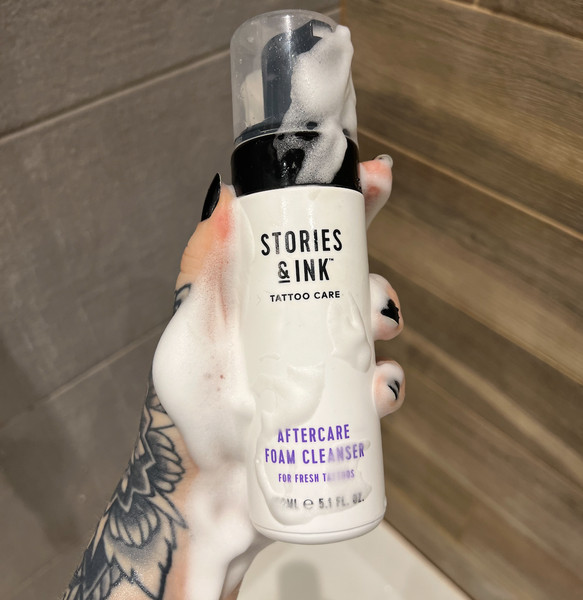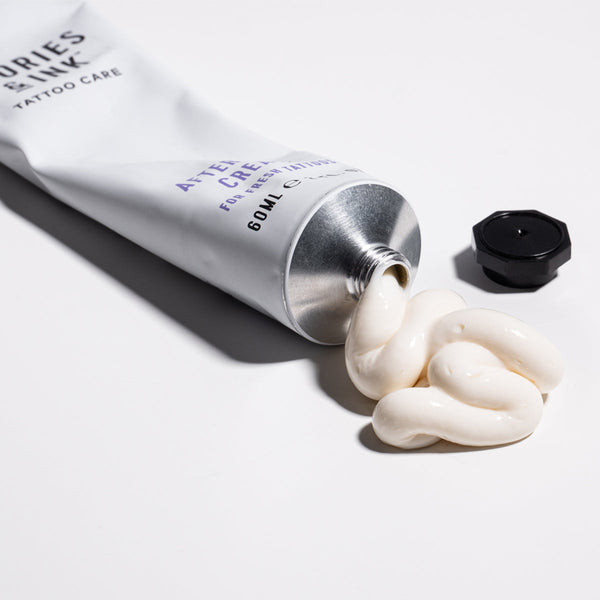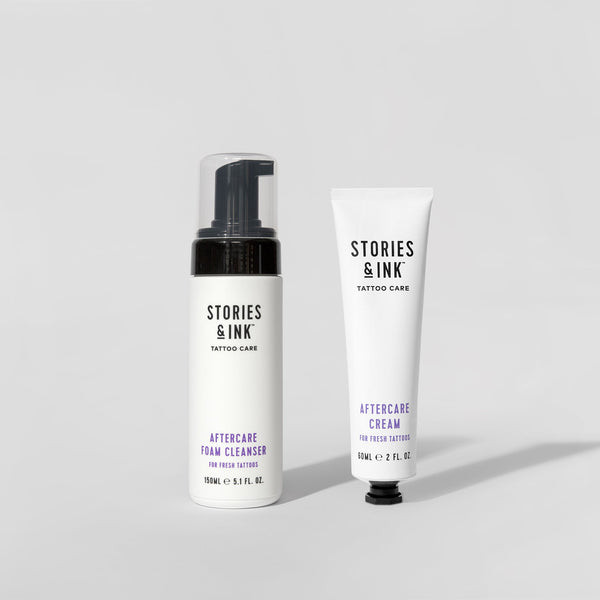Getting a new tattoo is exciting, but understanding the healing process is crucial for preserving its beauty and preventing complications. How Long Until My Tattoo Heals? Typically, a tattoo takes 2 to 4 weeks to heal on the surface, but the skin underneath can continue to repair itself for up to 6 months. At tattooat.com, we provide comprehensive guidance and resources to ensure your tattoo heals beautifully, including timelines, aftercare tips, and when to seek professional advice. Let’s explore the healing process in detail, ensuring your body art remains a vibrant expression of your individuality.
1. Understanding the Tattooing Process
To fully grasp the tattoo healing timeline, it’s essential to understand how a tattoo is applied. During the process, a tattoo machine punctures the skin with needles, depositing ink into the dermis layer. This creates a controlled wound that the body naturally works to repair. According to research from Portland State University’s Art Department, in July 2023, understanding the tattooing process can significantly enhance aftercare practices, leading to better healing outcomes.
1.1. How Tattooing Works
Liv Dodds, a tattoo artist from Northumberland, UK, explains the process: “Your skin has three layers: the epidermis, the dermis, and the hypodermis. With a tattoo, the ink enters the dermis, and your body recognizes it as a wound. Your body sends white blood cells (macrophages) to ‘destroy’ the ink. The macrophages stay in the dermis with the ink pigments, creating your tattoo.”
1.2. The Immediate Aftermath
Immediately after getting a tattoo, it’s normal to experience some swelling, redness, and irritation. This is a natural reaction to the trauma inflicted on the skin. These initial symptoms usually subside within the first 48 hours. Your tattoo artist will cover the new tattoo with a bandage, such as cling film or a second skin, to protect it from bacteria.
 Cling film tattoo protection
Cling film tattoo protection
2. The First 24 Hours: Critical Care
The first 24 hours are crucial for preventing infection and ensuring proper healing.
2.1. Keeping It Clean
“The most important part of the first 24 hours is keeping your tattoo clean and fresh,” says Liv Dodds. This means avoiding touching the tattoo (even by friends and family) and keeping it wrapped to minimize bacteria exposure.
2.2. Washing and Aftercare
Regularly washing the tattoo can keep it cool and clean. Liv recommends a “wet heal” approach: “I favor second skins and recommend up to 12 hours before removal, then opting for a ‘wet heal’ style process of washing it down two or three times a day and applying your aftercare after that.”
 Stories & Ink Aftercare Foam Cleanser
Stories & Ink Aftercare Foam Cleanser
2.3. Aftercare Foam Cleanser
Consider using a cleanser specifically designed for new tattoos, such as the Stories & Ink Aftercare Foam Cleanser. These products are formulated to soothe, calm, and repair damaged skin immediately after tattooing.
3. Essential Tattoo Healing Tips
To ensure optimal healing, consider these do’s and don’ts.
3.1. Dos
- Wear Loose Clothing: Choose clothing that won’t rub against the tattoo.
- Keep It Clean and Moisturized: Use natural, tattoo-friendly products.
- Let It Breathe: Allow the tattoo to air out for periods.
3.2. Don’ts
- Submerge in Water: Avoid baths, pools, and the sea while it heals. Showers are fine.
- Let Pets Lick It: Keep animals away from the tattoo.
- Heavy Exercise: Refrain from intense workouts for at least 48 hours.
- Pick at It: Avoid picking scabs or peeling skin.
- Expose to Direct Sunlight: Keep the tattoo covered in direct sunlight.
4. Tattoo Healing Timeline: Week by Week
The tattoo healing timeline can be divided into distinct stages, each with its own characteristics and care requirements.
4.1. Week 1: Initial Healing
In the first week, it’s normal to see redness, slight inflammation, swelling, oozing, or even a burning sensation. These symptoms are part of the body’s initial response to the tattooing process.
4.2. Week 2: Itching and Peeling
Week two can be quite itchy as the skin begins to flake and scab. It’s crucial to avoid picking at scabs or scratching the peeling skin, as this can prolong healing and cause scarring. During this stage, some ink may appear to come off, which is a normal part of the process.
4.3. Weeks 3 and 4: Dullness and Exfoliation
During weeks three and four, the new ink may appear less vibrant due to a layer of dry skin forming over the tattoo. This layer will naturally exfoliate over the next week or so, revealing the tattoo underneath in all its vibrant glory. Most of the earlier itchiness should subside during this stage.
4.4. Months 1 to 6: Long-Term Care
After the first month, any itching and redness should completely disappear, and the tattoo may look fully healed. However, the skin under the tattoo can continue to repair itself for up to six months. During this period, it’s important to maintain your aftercare routine to ensure the tattoo remains vibrant and healthy.
 Stories & Ink tattoo Aftercare Cream
Stories & Ink tattoo Aftercare Cream
5. Factors Influencing Tattoo Healing Time
Several factors can affect how quickly a tattoo heals.
5.1. Tattoo Size and Complexity
Dr. Nicolas Kluger, professor of Dermatology at Helsinki University Hospital, notes, “Light tattoos (drawings) will heal faster than tattoos with large areas covered by color. An eyebrow made by microblading will also heal quite fast. But one month is a safe limit to say whether there’s a problem or not.”
5.2. Tattoo Location
Generally, the location of a tattoo shouldn’t significantly affect healing time, but there can be exceptions. “Of course, if you get a tattoo on an area of constant rubbing like an ankle on a shoe, and you don’t keep resting it, this may impact healing,” says Dr. Kluger.
5.3. Medication and Health Conditions
Certain medications and health conditions can also delay healing. For example, Dr. Kluger advises against getting tattoos while on isotretinoin (a treatment for acne) or high doses of corticosteroids (anti-inflammatory drugs). Diabetic patients should ensure their diabetes is well-controlled during tattooing.
6. Recognizing Signs of Tattoo Infection
While severe reactions after getting a tattoo are rare, it’s important to recognize the signs of infection or allergic reaction.
6.1. Common Signs of Infection
- Persistent Redness: Redness that doesn’t improve after a few days.
- Skin Feels Hot: Skin radiating heat days after getting the tattoo.
- Oozing Fluid: Continuous discharge of fluid or pus two to three days after getting inked.
- Fever or Chills: General signs of infection.
- Worsening Pain: Pain that continues to increase days after getting the tattoo.
- Swollen, Puffy Skin: Swelling around the tattoo area, which may indicate an allergic reaction.
- Severe Itching or Hives: Intense itching or hives, suggesting an allergic reaction.
7. Tattoo Aftercare: Products and Practices
Proper aftercare is essential for a smooth and successful healing process.
7.1. Cleansing
Use a gentle, fragrance-free cleanser to wash the tattoo two to three times a day. This helps remove bacteria and keeps the area clean.
7.2. Moisturizing
Apply a thin layer of tattoo-specific moisturizer after each wash. Look for products that are natural, hypoallergenic, and free of fragrances and dyes. The Stories & Ink Aftercare Cream is an excellent option, as it is designed to soothe, hydrate, and repair damaged skin.
7.3. Protecting
Keep the tattoo protected from the sun by wearing loose clothing or using a tattoo-specific sunscreen once it is fully healed. Avoid prolonged exposure to water, such as swimming or soaking in a bath, during the healing process.
8. Addressing Common Concerns
Many people have questions and concerns about the tattoo healing process. Here are some frequently asked questions to help you navigate this period.
8.1. How Long Does a Tattoo Take to Heal?
Generally, it takes two to four weeks for a new tattoo to heal. If the tattoo hasn’t healed within a month, it’s important to consult with a healthcare professional, as there may be an underlying issue such as an infection or allergic reaction.
8.2. What Does a Healing Tattoo Look Like?
A healing tattoo goes through several stages. In the first few days, redness, oozing fluid, and swollen skin are common. After about two weeks, the skin may begin to peel. In weeks three and four, the tattoo may appear duller until the skin naturally exfoliates, revealing the vibrant tattoo underneath.
8.3. What Should I Put on a Healing Tattoo?
Your tattoo artist can provide specific recommendations on what to use on your healing tattoo. Products like the Stories & Ink Aftercare Cream are specifically designed to soothe, calm, and repair damaged skin after tattooing.
8.4. Can I Put Sunscreen on a Healing Tattoo?
It’s best to avoid applying sunscreen to a new tattoo until it is fully healed. Sunscreens contain ingredients that can irritate the skin and interfere with the healing process. Until then, protect the tattoo by covering it with loose clothing when you’re out in the sun.
9. The Science Behind Tattoo Healing
The healing of a tattoo is a complex biological process that involves several stages.
9.1. Inflammatory Phase
Immediately after getting a tattoo, the body initiates an inflammatory response. This is characterized by redness, swelling, and pain. During this phase, the immune system sends white blood cells to the area to prevent infection and begin the healing process.
9.2. Proliferative Phase
In the proliferative phase, the body starts to rebuild the damaged tissue. New blood vessels form, and collagen is produced to repair the skin. This phase is characterized by the formation of a protective layer of skin over the tattoo.
9.3. Maturation Phase
The maturation phase is the final stage of healing. During this time, the collagen fibers reorganize and strengthen, and the skin becomes smoother and more flexible. This phase can last for several months, and it’s important to continue caring for the tattoo during this time to ensure optimal healing.
10. Choosing the Right Tattoo Artist
Selecting a skilled and reputable tattoo artist is crucial for ensuring a safe and successful tattooing experience. A good artist will use sterile equipment, follow proper hygiene practices, and provide detailed aftercare instructions.
10.1. Research and Reviews
Take the time to research local tattoo studios and artists. Read reviews and check out their portfolios to get a sense of their style and skill level. Look for artists who specialize in the type of tattoo you want.
10.2. Consultation
Schedule a consultation with the artist to discuss your ideas and ask any questions you may have. A good artist will be willing to work with you to create a custom design that you’ll love.
10.3. Studio Environment
Make sure the tattoo studio is clean and well-maintained. The artist should use sterile, single-use needles and wear gloves during the tattooing process.
11. Exploring Tattoo Styles and Trends
Tattoos are a form of art, and there are countless styles and trends to explore.
11.1. Traditional Tattoos
Traditional tattoos are characterized by bold lines, simple designs, and bright colors. This style has been popular for decades and is often associated with sailors and Americana.
11.2. Realism Tattoos
Realism tattoos aim to replicate photographs or other images as accurately as possible. This style requires a high level of skill and attention to detail.
11.3. Watercolor Tattoos
Watercolor tattoos mimic the look of watercolor paintings, with soft, flowing colors and delicate lines. This style is often used for floral designs and other organic motifs.
11.4. Geometric Tattoos
Geometric tattoos feature precise shapes, patterns, and lines. This style can be used to create intricate and visually striking designs.
11.5. Blackwork Tattoos
Blackwork tattoos use only black ink to create bold, graphic designs. This style is often used for tribal motifs, abstract patterns, and minimalist designs.
12. The Importance of Hydration and Nutrition
Proper hydration and nutrition play a significant role in the tattoo healing process.
12.1. Hydration
Drinking plenty of water helps keep your skin hydrated and promotes healing. Aim to drink at least eight glasses of water a day, especially in the days following your tattoo appointment.
12.2. Nutrition
Eating a balanced diet rich in vitamins and minerals can also support the healing process. Focus on foods that are high in protein, vitamin C, and zinc, as these nutrients are essential for tissue repair.
13. Addressing Tattoo Discomfort
Getting a tattoo can be uncomfortable, but there are several ways to manage the pain.
13.1. Numbing Creams
Numbing creams can be applied to the skin before the tattoo appointment to help reduce pain. However, it’s important to talk to your tattoo artist before using a numbing cream, as some products can interfere with the tattooing process.
13.2. Breathing Techniques
Practicing deep breathing techniques can help you relax and manage pain during the tattoo appointment. Focus on taking slow, deep breaths and visualizing a calm, peaceful scene.
13.3. Distraction
Bringing a friend, listening to music, or watching a movie can help distract you from the pain and make the tattoo appointment more bearable.
14. Tattoo Aftercare Duo: Cleanser and Cream
For the best results, consider using the Stories & Ink Aftercare Duo for the first few weeks of healing.
 Stories & Ink Aftercare Duo
Stories & Ink Aftercare Duo
14.1. Aftercare Foam Cleanser
The Aftercare Foam Cleanser keeps fresh tattoos clean and free from bacteria.
14.2. Aftercare Cream
The Aftercare Cream nourishes, hydrates, and reduces inflammation, helping your skin to heal faster. Both products are 100% natural, dermatologically-tested, fragrance-free, hypoallergenic, vegan-friendly, and suitable for all skin types.
15. Tattoo Healing: Debunking Myths
There are many myths surrounding tattoo healing. Let’s debunk some of the most common ones.
15.1. Myth: Tattoos Heal Faster When Covered
Fact: Tattoos need air to heal properly. Covering a tattoo for too long can trap moisture and bacteria, increasing the risk of infection.
15.2. Myth: All Tattoo Aftercare Products Are the Same
Fact: Not all aftercare products are created equal. Look for products that are specifically designed for tattoo aftercare and that are free of harsh chemicals and fragrances.
15.3. Myth: Scabs Are Bad for Tattoos
Fact: Scabs are a natural part of the healing process. However, it’s important to avoid picking at scabs, as this can prolong healing and cause scarring.
15.4. Myth: Tattoos Don’t Fade Over Time
Fact: Tattoos can fade over time, especially if they are exposed to the sun. Proper aftercare and sun protection can help keep your tattoo looking vibrant for years to come.
16. Long-Term Tattoo Care
Once your tattoo is fully healed, it’s important to continue caring for it to keep it looking its best.
16.1. Sun Protection
Protect your tattoo from the sun by applying a high-SPF sunscreen whenever you’re going to be outdoors. Sun exposure can cause the ink to fade and can damage the skin.
16.2. Moisturizing
Keep your skin hydrated by moisturizing regularly. This will help keep the tattoo looking vibrant and prevent the skin from becoming dry and cracked.
16.3. Healthy Lifestyle
A healthy lifestyle can also contribute to the longevity of your tattoo. Eating a balanced diet, getting enough sleep, and avoiding smoking can all help keep your skin healthy and vibrant.
17. FAQ: Additional Questions About Tattoo Healing
17.1. Can I Exercise After Getting a Tattoo?
It’s best to avoid heavy exercise for at least 48 hours after getting a tattoo. Exercise can cause the skin to stretch and sweat, which can interfere with the healing process.
17.2. Can I Shave Over a Healing Tattoo?
Avoid shaving over a healing tattoo until it is fully healed. Shaving can irritate the skin and increase the risk of infection.
17.3. Can I Use Vaseline on My Tattoo?
While Vaseline can provide a protective barrier, it’s not ideal for tattoo aftercare. Vaseline can trap moisture and bacteria, increasing the risk of infection. Look for tattoo-specific moisturizers that are designed to promote healing and keep the skin hydrated.
17.4. What Should I Do if My Tattoo Is Still Red After a Month?
If your tattoo is still red after a month, it’s important to consult with a healthcare professional. Persistent redness can be a sign of infection or allergic reaction.
17.5. Can Tattoos Be Removed?
Yes, tattoos can be removed using laser tattoo removal. However, the process can be expensive and time-consuming, and it may not completely remove the tattoo.
18. Real Stories: Tattoo Healing Experiences
Hearing from others who have gone through the tattoo healing process can provide valuable insights and reassurance.
18.1. Sarah’s Story
“I got my first tattoo last year, and I was really nervous about the healing process. I followed all the aftercare instructions from my artist, and I used the Stories & Ink Aftercare Duo. My tattoo healed beautifully, and I’m so happy with the results!”
18.2. Michael’s Story
“I’ve gotten several tattoos over the years, and I’ve learned that proper aftercare is essential for a smooth healing process. I always make sure to keep my tattoos clean and moisturized, and I avoid picking at scabs. With proper care, my tattoos always heal quickly and look great.”
18.3. Emily’s Story
“I had a bad experience with a tattoo that got infected. I didn’t follow the aftercare instructions properly, and I ended up with a nasty infection. I learned my lesson, and now I always make sure to take proper care of my tattoos.”
19. Resources for Tattoo Lovers
There are many resources available for tattoo lovers, including websites, magazines, and social media groups.
19.1. Inked Magazine
Inked Magazine is a leading tattoo magazine that features articles on tattoo artists, styles, and trends.
19.2. Tattooat.com
tattooat.com offers a wealth of information on tattoo designs, artists, and aftercare, providing a comprehensive resource for tattoo enthusiasts.
19.3. Social Media Groups
There are many social media groups dedicated to tattoos, where you can connect with other tattoo lovers, share your experiences, and ask questions.
20. Call to Action
Ready to embark on your tattoo journey? Visit tattooat.com today to discover inspiring designs, find talented artists, and learn everything you need to know about tattoo aftercare. Explore our extensive library of articles, browse stunning tattoo galleries, and connect with a vibrant community of tattoo enthusiasts. Whether you’re a first-timer or a seasoned collector, tattooat.com is your ultimate guide to the world of tattoos.
Address: 1825 SW Broadway, Portland, OR 97201, United States
Phone: +1 (503) 725-3000
Website: tattooat.com